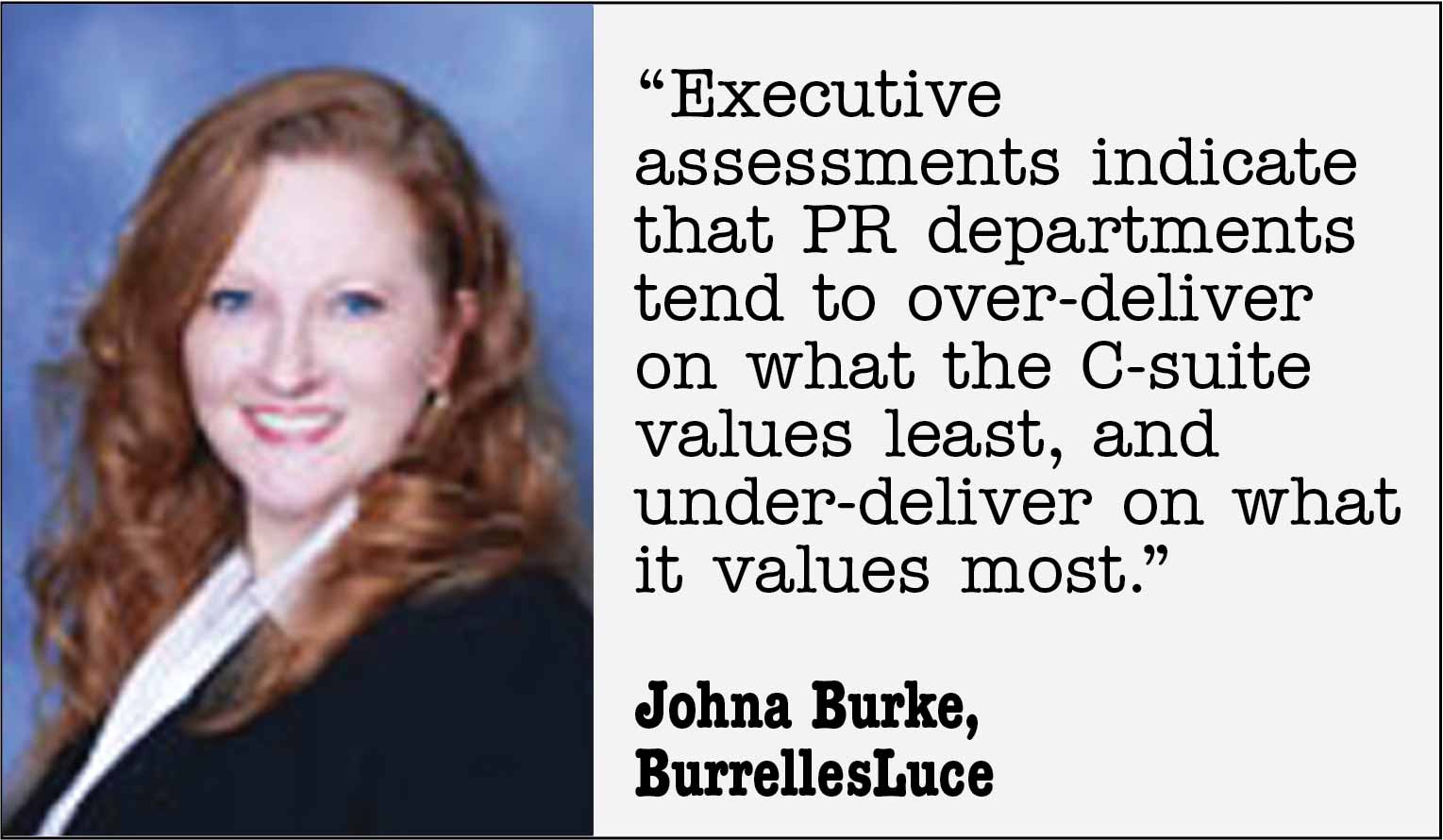Senior executives demand a measurable return on their investment in PR. Unfortunately, many PR professionals are insecure in their mastery of measurement tactics. A further complication: The executives demanding metrics often don’t know enough about PR to provide guidance. The result: stasis.
According to Johna Burke, senior VP at BurrellesLuce, and Mark Weiner, CEO at PRIME Research, Americas, two primary motivations drive PR people to measure: to “communicate value” and to “improve performance.” For PR people to prove value, they must first uncover the often secret value system executives maintain and align executive opinions with what is reasonable and measurable for PR to deliver.
 |
Weiner recommends an executive audit—a confidential, anonymous survey of senior executives. “Some executives know what is reasonable and achievable while others don’t,” he says. “The audit is a clean-slate approach to uncover what executives know and what they seek from PR.”
Once 20 to 30 key decision-makers are interviewed, the PR professional can guide one-on-one discussions to negotiate greater alignment based on the audit findings, says Weiner. Dozens of unqualified PR objectives cited by execs can be pared down to three or four mutually agreed-upon priorities, as well as preferred methods for communicating results.
Burke suggests that the measures found most meaningful by senior executives include simple and accessible benchmarks such as “volume of coverage versus goal,” “percentage of coverage from key markets” and “percentage of coverage containing at least one key message.” Even if these practical and affordable metrics don’t make a strict connection to ROI, they do indicate to the C-suite that PR resources are spent wisely.
 |
Weiner says that after conducting thousands of executive interviews in support of audits undertaken for organizations large and small, for-profit and nonprofit, domestic and global, two general executive preferences emerge: PR measurement that is clearly associated with PR (the most popular of which are “raising awareness” and “delivering key messages to target media”) and measurement that is applicable to generally any function (the most popular of which are “quality completion of projections” and “meet or beat objectives”).
Executive assessments indicate that PR departments tend to over-deliver on what senior executives value least (a high volume of press clippings and advertising value, for example), and under-deliver on what they value most (raising awareness and delivering key messages to key markets), according to Burke, who adds that executives don’t place particular emphasis on PR’s ability to drive sales. “While considered meaningful, it’s not considered a reasonable or measurable criterion,” she says.
ASK THE RIGHT QUESTIONS
On the basis of the Barcelona Principles, Burke suggests that every PR investment decision maker should ask the following questions:
• Are we conducting solid, salient PR research? Are we mistaking quantitative research for qualitative?
• How do we ensure that resources are optimized?
• Do we know which agents deliver the best ROI?
• Does the PR team understand the priorities of the organization? When was the last time we conducted an executive audit?
• Can we identify the markets with the highest concentration of our target audience and the media they listen to, read and watch?
• Do we do more than clip counting when assessing the media’s treatment of our company, our brands and the issues we prioritize?
• Have we assessed the transformations under way in the media business? How are we capitalizing on them?
• Given the increased access, abundance and speed of information in our current society, how are we making the most of our opportunities?
• What controls do we have in place to ensure that our initiatives can be measured and held accountable? How do we apply what we learn to make even better decisions in the future?
ASSESS EXPECTATIONS
Offer additional guidelines to uncover what your executives want. “Begin by assessing the attitudes, preferences, needs and expectations among those executives with influence over funding and evaluation for your PR program effort. Negotiate, align and confirm,” Weiner says.
Both Burke and Weiner suggest that as part of your discovery and alignment process, you begin by assessing the following:
• Goals and objectives of the organization and how they relate to public relations and corporate communications.
• Professional attributes (good writing, media skills, etc.)
• Activities and tactics (media relations, strategic PR guidance, social media, etc.)
• Achievement of client and company-wide objectives.
• Media considered most credible, most important.
• Messages considered most credible, most compelling.
• The standards by which public relations effectiveness should be measured (and what drives success in the opinion of this key audience).
• The extent to which public relations now satisfies these preferences, needs and expectations.
The executive audit discovery process sets the stage for ongoing dialogue in terms that are meaningful, educational and consensus-building. They provide the feedback needed by PR pros to continually improve departmental and personal performance in meeting the needs of key executives. PRN
CONTACT:
Johna Burke, [email protected]; Mark Weiner, [email protected].
